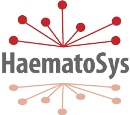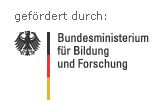HaematoSys
Systembiologie der Hämatopoese und hämatopoetischer Neoplasien
Subproject 2 ¿ Modelling mature blood formation
Applicants: Christoph Engel (CE), Manja Kamprad (MK), Markus Scholz (MS)
Associated partners: Pfreundschuh (DSHNHL), v Minckwitz (GBG). Diehl/Engert (GHSG)
Background and own contributions: Haematopoietic growth factors are routinely used in the framework of polychemotherapies in order to avoid or ameliorate cytopenias. We showed in the past that optimal schedules for growth factor application can be estimated by modelling the dynamics of haematopoietic lineages during chemotherapy and growth factor application in the murine and human situation [e.g. 1.9-1.11]. The established ordinary differential equation (ODE) models also allow predicting optimised growth factor schedules for newly designed dose-dense chemotherapies depending on individual haematotoxicity risk factors. Model predictions have been validated in clinical trials and mouse experiments. So far, there is no model which can represent the time course of all haemetopoietic lineages under chemotherapy and growth factor application simultaneously. The Leipzig group has working models of all of these lineages separately but not in a joined fashion and not yet related to chemotherapy data for erythropoiesis and platelet formation.
Objective: The aim of this project is to construct a comprehensive ODE model of murine and human haematopoiesis under chemotherapy and growth factor application. The model will represent all three major haematopoietic lineages (granulo-, erythro-, thrombopoiesis) in parallel and should map their interactions. Pharmacokinetic / –dynamic models of the growth factors granulocyte-colony stimulating factor (G-CSF), erythropoetin (EPO), thrombopoetin (TPO) and corresponding pharmaceutical derivatives will be included. The effect of major chemotherapeutic drugs will be modelled in dependence on their dosing and timing schedules, and, in the human situation, on individual risk factors for toxicity.
Available data: For humans, we have access to the time courses of granulocytes, thrombocytes and haemoglobin of patients treated with different chemotherapeutic regimens and growth factors (more than 10 different chemotherapies of non-Hodgkin’s lymphoma, Hodgkin’s disease and breast cancer, more than 5.000 patients and 30.000 cycles). These data were collected by collaborating national study groups (DSHNHL, GHSG, GBG). For mice and rats, we have time courses of blood cells after experimental chemotherapies and G-CSF applications, G-CSF serum concentrations and bone marrow data [e.g. 1.12]. Our datasets for humans and mice are accomplished by literature data.
Work program: Modelling in mice. Our existing ODE-models of murine granulo-, erythro-, and thrombopoiesis will be extended by introducing pharmacokinetic/ –dynamic models of growth factor applications. Additional experiments are required with respect to the pharmacokinetics and –dynamics of EPO or TPO. We will measure cytokine concentrations, time courses of bone marrow cell stages and mature blood cells after application of these cytokines. In order to model the damaging effects of chemotherapy it is necessary to perform additional mice experiments with respect to the dose-dependent bone-marrow toxicity of the most important cytotoxic drugs. Corresponding characteristics will be estimated from the data and implemented into the models. Finally, we aim at combining the isolated models of all lineages into one model in which all lineages originate from a common simplified model of stem cell regulation.
Modelling in humans. The models in mice will be translated to the human situation by keeping identified model mechanisms, but changing model parameters appropriately. Since human bone marrow is not accessible, it is necessary to estimate corresponding parameters indirectly by fitting predicted time courses of circulating blood cells to data. First, we identify human parameters for the pharmacokinetic/-dynamic models of growth factor applications on the basis of own study data and literature data. Next, we estimate dose-toxicity characteristics for important cytotoxic agents on the basis of available study data of dose-intensified chemotherapeutic regimen. Additionally, we estimate the bone marrow toxicity for fixed doses of other drugs. We account for known clinical risk factors with respect to cell toxicity of drugs by assuming different toxicity parameters for different risk groups. Finally, we combine the models of single lineages analogously to the mice model.

